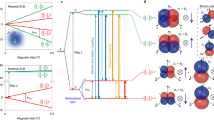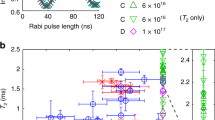Abstract
Silicon is one of the most promising semiconductor materials for spin-based information processing devices1,2. Its advanced fabrication technology facilitates the transition from individual devices to large-scale processors, and the availability of a 28Si form with no magnetic nuclei overcomes a primary source of spin decoherence in many other materials3,4. Nevertheless, the coherence lifetimes of electron spins in the solid state have typically remained several orders of magnitude lower than that achieved in isolated high-vacuum systems such as trapped ions5. Here we examine electron spin coherence of donors in pure 28Si material (residual 29Si concentration <50 ppm) with donor densities of 1014–1015 cm−3. We elucidate three mechanisms for spin decoherence, active at different temperatures, and extract a coherence lifetime T2 up to 2 s. In this regime, we find the electron spin is sensitive to interactions with other donor electron spins separated by ~200 nm. A magnetic field gradient suppresses such interactions, producing an extrapolated electron spin T2 of 10 s at 1.8 K. These coherence lifetimes are without peer in the solid state and comparable to high-vacuum qubits, making electron spins of donors in silicon ideal components of quantum computers2,6, or quantum memories for systems such as superconducting qubits7,8,9.
This is a preview of subscription content, access via your institution
Access options
Subscribe to this journal
Receive 12 print issues and online access
$259.00 per year
only $21.58 per issue
Buy this article
- Purchase on Springer Link
- Instant access to full article PDF
Prices may be subject to local taxes which are calculated during checkout




Similar content being viewed by others
References
Appelbaum, I., Huang, B. Q. & Monsma, D. J. Electronic measurement and control of spin transport in silicon. Nature 447, 295–298 (2007).
Kane, B. E. A silicon-based nuclear spin quantum computer. Nature 393, 133–137 (1998).
De Sousa, R. & Das Sarma, S. Theory of nuclear-induced spectral diffusion: Spin decoherence of phosphorus donors in Si and GaAs quantum dots. Phys. Rev. B 68, 115322 (2003).
Bluhm, H. et al. Dephasing time of GaAs electron-spin qubits coupled to a nuclear bath exceeding 200 μs. Nature Phys. 7, 109–113 (2011).
Langer, C. et al. Long-lived qubit memory using atomic ions. Phys. Rev. Lett. 95, 060502 (2005).
Ladd, T. D. et al. Quantum computers. Nature 464, 45–53 (2010).
Wesenberg, J. H. et al. Quantum computing with an electron spin ensemble. Phys. Rev. Lett. 103, 070502 (2009).
Kubo, Y. et al. Strong coupling of a spin ensemble to a superconducting resonator. Phys. Rev. Lett. 105, 140502 (2010).
Schuster, D. I. et al. High-cooperativity coupling of electron-spin ensembles to superconducting cavities. Phys. Rev. Lett. 105, 140501 (2010).
Kane, B. E. Silicon-based quantum computation. Forts. Phys. Prog. Phys. 48, 1023–1041 (2000).
Feher, G. & Gere, E. A. Electron spin resonance experiments on donors in silicon. 2. Electron spin relaxation effects. Phys. Rev. 114, 1245–1256 (1959).
Castner, T. G. Orbach spin-lattice relaxation of shallow donors in silicon. Phys. Rev. 155, 816–825 (1967).
Gordon, J. P. & Bowers, K. D. Microwave spin echoes from donor electrons in silicon. Phys. Rev. Lett. 1, 368–370 (1958).
Tyryshkin, A. M., Lyon, S. A., Astashkin, A. V. & Raitsimring, A. M. Electron spin relaxation times of phosphorus donors in silicon. Phys. Rev. B 68, 193207 (2003).
Schenkel, T. et al. Electrical activation and electron spin coherence of ultralow dose antimony implants in silicon. Appl. Phys. Lett. 88, 112101 (2006).
George, R. E. et al. Electron spin coherence and electron nuclear double resonance of Bi donors in natural Si. Phys. Rev. Lett. 105, 067601 (2010).
Morley, G. W. et al. The initialization and manipulation of quantum information stored in silicon by bismuth dopants. Nature Mater. 9, 725–729 (2010).
Abe, E. et al. Electron spin coherence of phosphorus donors in silicon: Effect of environmental nuclei. Phys. Rev. B 82, 121201 (2010).
Witzel, W. M., de Sousa, R. & Das Sarma, S. Quantum theory of spectral-diffusion-induced electron spin decoherence. Phys. Rev. B 72, 161306 (2005).
Becker, P., Pohl, H. J., Riemann, H. & Abrosimov, N. Enrichment of silicon for a better kilogram. Phys. Status Solidi A 207, 49–66 (2010).
Klauder, J. R. & Anderson, P. W. Spectral diffusion decay in spin resonance experiments. Phys. Rev. 125, 912–932 (1962).
Salikhov, K. M., Dzuba, S. A. & Raitsimring, A. M. The theory of electron spin-echo signal decay resulting from dipole–dipole interactions between paramagnetic centers in solids. J. Magn. Reson. 42, 255–276 (1981).
Kurshev, V. V. & Ichikawa, T. Effect of spin flip-flop on electron-spin-echo decay due to instantaneous diffusion. J. Magn. Reson. 96, 563–573 (1992).
Witzel, W. M., Carroll, M. S., Morello, A., Cywinski, L. & Das Sarma, S. Electron spin decoherence in isotope-enriched silicon. Phys. Rev. Lett. 105, 187602 (2010).
Mims, W. B. Phase memory in electron spin echoes lattice relaxation effects in CaWO4: Er, Ce, Mn. Phys. Rev. 168, 370–389 (1968).
Hu, P. & Hartmann, S. R. Theory of spectral diffusion decay using an uncorrelated-sudden-jump model. Phys. Rev. B 9, 1–13 (1974).
Zhidomirov, G. M. & Salikhov, K. M. Contribution to theory of spectral diffusion in magnetically diluted solids. Sov. Phys. JETP USSR 29, 1037–1040 (1969).
Maze, J. R. et al. Nanoscale magnetic sensing with an individual electronic spin in diamond. Nature 455, 644–647 (2008).
Kittel, C. & Abrahams, E. Dipolar broadening of magnetic resonance lines in magnetically diluted crystals. Phys. Rev. 90, 238–239 (1953).
Rhim, W. K., Elleman, D. D. & Vaughan, R. W. Analysis of multiple pulse NMR in solids. J. Chem. Phys. 59, 3740–3749 (1973).
Acknowledgements
We thank W. M. Witzel and A. Morello for helpful discussions. Work at Princeton was supported by the National Science Foundation (NSF) through the Princeton Materials Research Science and Engineering Center (DMR-0819860) and the National Security Agency (NSA)/Laboratory for Physical Sciences through Lawrence Berkley National Laboratory (LBNL) (100000080295), at Keio by the Grant-in-Aid for Scientific Research and Project for Developing Innovation Systems by the Ministry of Education, Culture, Sports, Science and Technology, the FIRST Program by the Japan Society for the Promotion of Science, and the Japan Science and Technology Agency/UK Engineering and Physical Sciences Research Council (EPSRC) (EP/H025952/1), at Oxford by the EPSRC through the Centre for Advanced Electron Spin Resonance (EP/D048559/1), at LBNL by the US Department of Energy (DE-AC02-05CH11231) and the NSA (100000080295), and at Simon Fraser University by the Natural Sciences and Engineering Research Council of Canada. J.J.L.M. is supported by the Royal Society.
Author information
Authors and Affiliations
Contributions
A.M.T., S.T., J.J.L.M., T.S., M.L.W.T., K.M.I. and S.A.L. conceived and designed the experiments. A.M.T., S.T. and J.J.L.M. performed the ESR experiments. A.M.T., J.J.L.M. and S.A.L. analysed the measurements. H.R., N.V.A., P.B., H-J.P., M.L.W.T. and K.M.I. prepared the 28Si samples. A.M.T., J.J.L.M. and S.A.L. wrote the manuscript with input from the other co-authors.
Corresponding author
Ethics declarations
Competing interests
The authors declare no competing financial interests.
Supplementary information
Supplementary Information
Supplementary Information (PDF 588 kb)
Rights and permissions
About this article
Cite this article
Tyryshkin, A., Tojo, S., Morton, J. et al. Electron spin coherence exceeding seconds in high-purity silicon. Nature Mater 11, 143–147 (2012). https://doi.org/10.1038/nmat3182
Received:
Accepted:
Published:
Issue Date:
DOI: https://doi.org/10.1038/nmat3182
This article is cited by
-
Individually addressable and spectrally programmable artificial atoms in silicon photonics
Nature Communications (2023)
-
Coherence protection of spin qubits in hexagonal boron nitride
Nature Communications (2023)
-
Probing many-body dynamics in a two-dimensional dipolar spin ensemble
Nature Physics (2023)
-
Long-lived electronic spin qubits in single-walled carbon nanotubes
Nature Communications (2023)
-
Universal logic with encoded spin qubits in silicon
Nature (2023)



